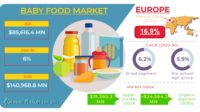Trends
Ruiz Foods Eyes Product Innovation and the Contentious Front-of-Pack Ingredient Discussion
At the IFT FIRST Conference, Mimi Bonnett of Innova Market Insights spotlighted the top food trends in the U.S. and Canada, while Michael Warter of Ruiz Foods delivered insights on machine learning and AI.

The two overriding themes at the annual IFT FIRST conference in Chicago was manufacturing growth and new applications for alternative protein. Image courtesy of Grant Gerke
Two in five consumers say protein is the most important ingredient when purchasing food in the U.S. and Canada, according Innova Market Insights. These types of insights were on display at the annual IFT FIRST Conference in Chicago, produced by the Institute of Food Technologists (IFT).
While this annual event focuses on food and beverage ingredient trends, the conference also touches on plant processing issues. Integrating automation and system software across plants is an imminent challenge for many large food and beverage manufacturers. The challenge is immense and comes with many pain points, such as where to start implementing and what are the best practices for data standardization across the enterprise?
During a Business FIRST session, Michael Warter, SVP and CIO at Ruiz Foods Products, Inc., addressed these challenges. The company recently moved its enterprise resource planning (ERP) and product lifecycle management (PLM) platform from on-premise to the cloud. In addition to Warter, Sandeep Anand, head of machine learning solution at Infor, joined the discussion to provide insights on current ERP and PLM technology trends.
Based in Frisco, Texas, Ruiz Foods is a major supplier of frozen foods. The food giant has more than 4,000 employees and four facilities across California, Texas and South Carolina. "To give you a sense of volume, we have four plants across the United States," said Warter at the IFT First conference. "When all these plants run, we produce a million pounds of food daily."
The company uses Infor's ERP and PLM solutions, which include a food and beverage module for manufacturing, quality assurance (QA) and finance. In addition, there's a suite that provides demand planning and scheduling.
During the discussion, Warter explained the challenges of moving away from on-premise ERP and PLM and how it required data standardization from all its business units. With the help of Infor's CTO and Doppio Group, Ruiz Foods devised a plan to transition gradually to the cloud instead of moving everything simultaneously. "We were able to find a way to step into the cloud without having to do it all at once as a big bang," said Warter.

Connecting Multiple Sites
Recently, there's been much discussion about approaches to large automation projects across multiple sites for food and beverage companies. Ruiz Foods started with Infor's on-premise ERP platform seven years ago. Eventually, it moved to Infor's software as a service (SAAS) ERP and PLM cloud offering approximately a year and a half ago. This move reduces hardware requirements and internal IT costs.
One challenge with the move to the cloud was substantial data entry for its R&D business unit. "Data was in disparate systems, and integration was vital in getting the systems to work together and move away from spreadsheets," said Warter during the discussion. "The first step provided regulatory, compliance, and track-and-trace benefits."
The cloud move allows Ruiz Foods to connect R&D to all plants. "It was essential for Ruiz Foods to have our R&D department connected to manufacturing," said Warter. "All manufacturing data goes into our PLM, and we can cost new raw materials and understand what products are worth."
Anand leads the machine learning and artificial intelligence solutions team at Infor and discussed the challenges of implementing so many moving parts. "A company needs an end goal and needs to break it down into smaller goals," said Anand. “How do I finish this project quickly and pragmatically so you're not looking at some big investment with some real pie-in-the-sky approach?"
The AI Roadmap for Ruiz Foods’ Supply Chain
"The cloud strategy only works if there's clean data,” said Warter. “With clean data, the advantages are quicker processes and the ability to apply AI.”
The current AI debate in large food and beverage companies is similar to the discussion of capital expenditures for cybersecurity tools in the operations technology (OT) segment. Many executives and board members believe investment is needed, but it takes time to define immediate concerns.
During the panel discussion, Warter said the company is defining its AI strategy. "The big driver of success is bringing everyone into the AI equation," said Anand. "How do you make the food scientist's role or the supply chain manager's job easier? And how can we be more effective in planning for the raw materials?"
For Ruiz Foods, product development is king. "Our lifeblood is innovation," said Warter. “One aspect of generative AI is the ability to pull together ideas on how to use ingredients and use this for product development." Besides product innovation, Warter also pointed out improved plant efficiencies with more machine learning. Warter cited that increased yields could be realized between plants that have varying degrees of humidity.
"We could use machine learning to understand what factors impact yield from recipes and how they differ between each plant or even per shift. This would be a big win for us," said Warter.
Process adherence is another priority for Ruiz Foods. In the near future, Infor will announce new tooling that will support enhanced process mining and this will allow Ruiz Foods to identify manufacturing bottlenecks and compare how business processes are performing across the enterprise.
"We see those combinations helping drive yield, innovation and process adherence," said Warter. "So we're super bullish on what that's going to mean for our overall manufacturing process."
How to Add Enterprise Solutions Across Plants
Infor’s approach with Ruiz Foods relies on 90-day agile increments of evaluate, setup and measure. The company relies on these how-to best steps to roll out its technology:
- An assessment of business challenges and data to determine what will be the highest priority across six intelligence areas.
- Of these six, what is your biggest priority?
- Identify business challenges, Return on Investment (ROI) assumptions and anchor a use case.
- Determine data availability and integrity.
- After selecting a use case, validate the data, generate the results and iterate to tune the model and insights to your changing needs; ensuring you can act on these insights within 90 days to production.
- Start getting results as early as 90 days.
- Implement anchor use case and validate economic benefits.
- Visualize predictive data insight.
- Start getting results as early as 90 days.
- Continuous monitoring and support, making sure there is a plan for additional use cases to continually promote accuracy, visibility and speed.
- Access ongoing support and ideation
- Develop plan for additional use case activation
Spotlight on Front of Pack Labeling and Alt Protein

Innova Markets Insights' presentation at the IFT FIRST conference revealed how ingredient labeling is changing. Food companies are moving ingredients to front-of-pack (FOP) labeling, which is being driven by consumers, regulators and package designers.
For years, food and beverage brands used product images or logos on the front of labels as the “hero” focal point for the package. Due to the popularity of protein-based foods and snacks, brands are moving the healthy ingredients to the front of packages.
"Approximately 70% of consumers don't look at the ingredient deck (on the back panel) of the package," Mimi Bonnett, senior director of insights at Innova Marketing Insights, said during her presentation, "Top Trends 2024: U.S. and Canada."
Bonnett highlighted, "[A]dditional ingredient information on the package's front label could be overloaded and cause consumer distraction."

However, packaging designers are leaning into a bold-minimal style for Gen Z consumers, including the front of the packaging. Hernán Braberman, creative director at Tridimage, spotlighted the use of the bold-minimal style in a recent article. Braberman says the bold-minimal approach "strips away extraneous details and focuses on clean lines and bold typography.” Braberman says that bold-minimal packaging speaks to Gen Z's appreciation for authenticity and skepticism toward marketing hype.
Popular ingredients are appearing on the front of packs, including protein, sugar, chicken breast, egg whites and bone broth. "This product is one of my favorite examples, WILDE Protein Chips," said Bonnett. “They're essentially chips or snacks made out of white meat protein, and there's a lot going on in the packaging, which calls out that this product is all about quality protein.”
Regulatory Alert: More Ingredients Coming to the Front-of-Pack
The Food and Drug Administration (FDA) is adding tension to the front-of-pack ingredient trends. The FDA announced that it will require food and beverage manufacturers to disclose "added sugars" on the front of packaging. The new rules for added sugars are due in October, according to the FDA, in an attempt to educate consumers about this ingredient.
Recently, the Sugar association responded about the upcoming added sugar labeling. The association believes new rules may be more about formulation than informing consumers. "Seventy-five percent of consumers support front-of-pack labeling," Courtney Gaine, Ph.D., president and chief executive officer at The Sugar Association, told attendees at the International Sweetener Symposium in August. "But without added information about calories, use of artificial sweeteners to replace sugar and other information, the added information is lacking."
According to Innova's research, 28% of consumers use proteins for energy and stamina, while another 26% focus on weight management. In 2024, Bonnet said the alt protein story has also moved away from burgers, with 25% of consumers wanting to add more plant-based proteins to their diets.
For product development, Innova Market Research touches on meat displacement trends. When consumers replace meat, surveys show that 41% choose vegetables and 31% legumes, while 16% pick plant-based meat substitutes. Innova concludes that "many consumers turn to vegetables or vegetable-based foods, and standalone plant-based proteins like legumes and nuts may have the opportunity to be highlighted in new product innovations.”
Other Innova Market Research Findings:
- Rice protein is often used in sports powders, cereals and energy bars, as well as in burgers, ground meat and meatball substitutes.
- Weight management is the number one concern for all generations: Boomers, Gen X, Millenials and Gen Z.
- When looking at new food and beverage product launches with plant-based proteins in the U.S. and Canada, Innova sees that one in three of these launches contain wheat gluten protein (2019-2023).
- Rice and wheat protein isolate are the fastest-growing plant-based proteins, with a compound annual growth rate (CAGR) of 3% and 2%, respectively (2019-2023).
Looking for a reprint of this article?
From high-res PDFs to custom plaques, order your copy today!





